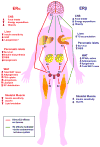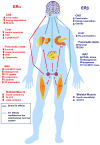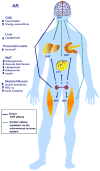Estrogen and androgen receptors: regulators of fuel homeostasis and emerging targets for diabetes and obesity
- PMID: 21109497
- PMCID: PMC3011051
- DOI: 10.1016/j.tem.2010.10.002
Estrogen and androgen receptors: regulators of fuel homeostasis and emerging targets for diabetes and obesity
Abstract
Because of increasing life expectancy, the contribution of age-related estrogen or androgen deficiency to obesity and type 2 diabetes will become a new therapeutic challenge. This review integrates current concepts on the mechanisms through which estrogen receptors (ERs) and androgen receptor (AR) regulate energy homeostasis in rodents and humans. In females, estrogen maintains energy homeostasis via ERα and ERβ, by suppressing energy intake and lipogenesis, enhancing energy expenditure, and ameliorating insulin secretion and sensitivity. In males, testosterone is converted to estrogen and maintains fuel homeostasis via ERs and AR, which share related functions to suppress adipose tissue accumulation and improve insulin sensitivity. We suggest that ERs and AR could be potential targets in the prevention of age-related metabolic disorders.
Figures



References
-
- Wild S, Roglic G, Green A, Sicree R, King H. Global prevalence of diabetes: estimates for the year 2000 and projections for 2030. Diabetes Care. 2004;27:1047–1053. - PubMed
-
- Alberti KG, Zimmet P, Shaw J. Metabolic syndrome--a new world-wide definition. A Consensus Statement from the International Diabetes Federation. Diabet Med. 2006;23:469–480. - PubMed
-
- Carr MC. The emergence of the metabolic syndrome with menopause. J Clin Endocrinol Metab. 2003;88:2404–2411. - PubMed
Publication types
MeSH terms
Substances
Grants and funding
LinkOut - more resources
Full Text Sources
Other Literature Sources
Medical
Research Materials

